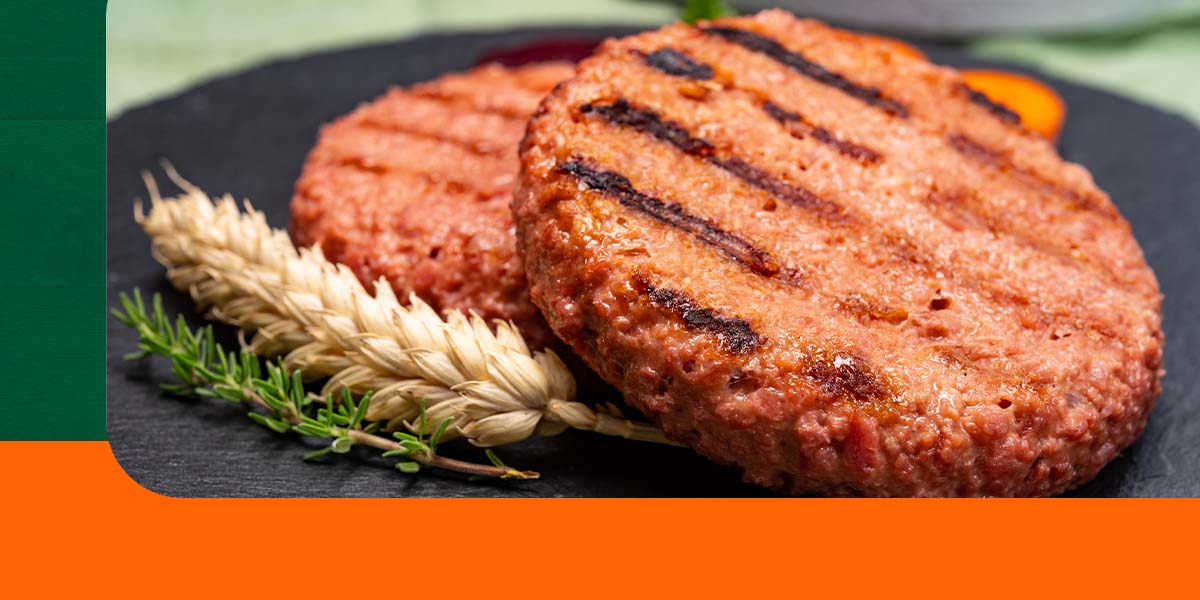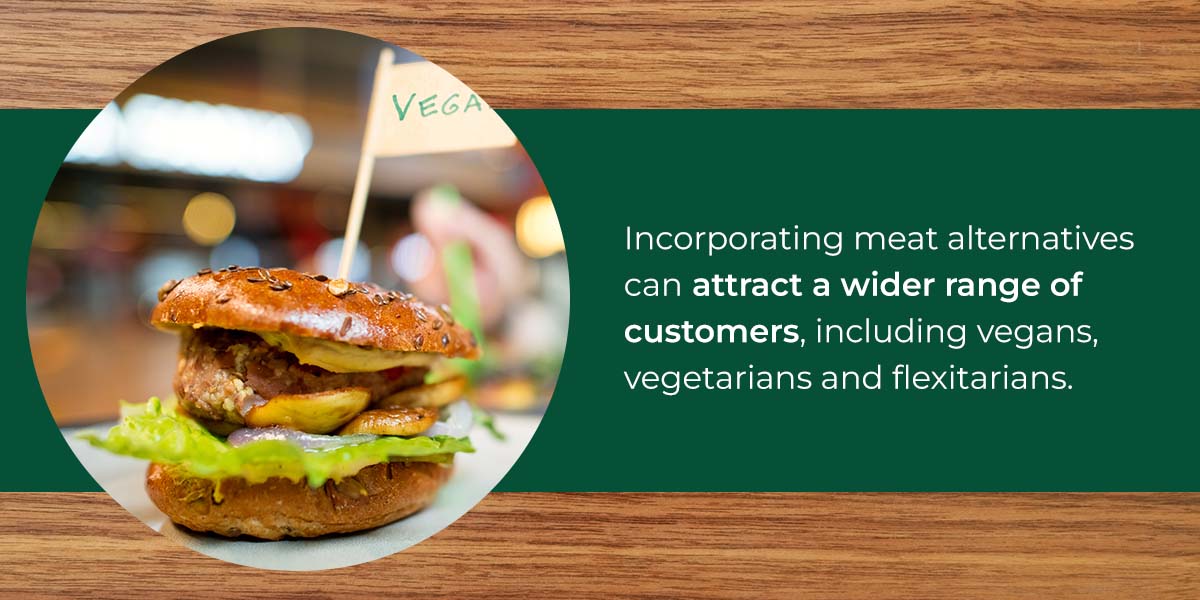Guide to Impossible Meats for Your Restaurant
The rise of meat alternatives is part of a larger trend toward plant-based eating. Meat alternatives — like those created by Impossible Foods — deliver the rich, savory flavors people love about meat, making them appealing to meat lovers and vegans alike. Meat alternatives are versatile, and there are several ways to add Impossible meat to your menu, from pasta and salads to burgers. With Impossible Foods products, you can get creative with your menu, offer plant-based versions of popular dishes or create entirely new offerings.
Whether your customers crave a classic cheeseburger or want to explore new sustainable dining options, adding meat alternatives to your menu allows you to offer something for people with various dietary preferences.
What Is Impossible Meat?
Impossible Foods creates plant-based products that are designed to look, cook and taste like real meat. Impossible products are made from plants and packed with nutrients, and they offer an environmentally friendly alternative to traditional meat. Making these products requires less water, uses less land and produces fewer greenhouse gas emissions than traditional meat.
Since it’s made from plants, this product appeals to vegans and vegetarians. Some people also view plant-based meat as a healthier option than traditional meat, as it contains no cholesterol and can be lower in saturated fat.
How It’s Made
Impossible meat is made using a variety of plant-based ingredients. These primarily include:
- Soy protein: Soy protein is the primary ingredient in Impossible Foods products, giving their Impossible beef, sausage, chicken, pork and meatballs a nutritional boost.
- Coconut and sunflower oil: These oils add fat, helping to make the product juicy and providing a mouthfeel similar to real meat.
- Heme: Heme is a key ingredient, giving the meat its unique flavor and smell during cooking. It occurs naturally in animal muscle, but Impossible Foods produces heme using genetically modified yeast. As the yeast ferments, it creates a version of heme that’s nearly identical to what we find in meat.
- Binders and flavorings: Ingredients like potato protein and plant fibers like methylcellulose help bind everything together. Natural flavors and colorings, such as beet juice, help Impossible products look and taste more like meat.
Can ‘Impossible’ Apply to Other Food Groups?
While Impossible Foods currently focuses on plant-based meat alternatives, the brand’s popularity has led many people to colloquially refer to other plant-based alternatives as “Impossible.”
Other brands have innovated to create products like:
- Plant-based cheese.
- Plant-based whipped cream.
- Plant-based cream cheese.
- Plant-based mayonnaise.
- Plant-based eggs.
These products appeal to vegan customers, as well as individuals who are curious about exploring vegan options.
What Are the Benefits of Impossible Meat?
Offering vegan options at your restaurant yields several benefits:
- Attract a broader customer base: Incorporating meat alternatives can attract a wider range of customers, including vegans, vegetarians and flexitarians. This can help increase foot traffic and diversify your customer base, potentially leading to sales increases.
- Gain a competitive edge: With more people opting for plant-based foods, adding Impossible meat dishes to your menu lets you stay competitive in the market and keep up with industry trends. This dietary inclusivity can enhance customer loyalty and satisfaction, as guests appreciate having choices that align with their diets.
- Appeal to sustainably-minded customers: Customers are increasingly prioritizing sustainability. Offering meat alternatives shows you want to be environmentally responsible, which can enhance your reputation and appeal to customers who prioritize sustainability.
- Position your brand as innovative: Plant-based meat is a growing trend in the food industry. By incorporating Impossible beef, pork, sausage or chicken into your menu, you position your establishment as innovative and in tune with food trends.
- Enjoy positive word-of-mouth: Adding Impossible meat to your menu is a great marketing tool. You can promote your new plant-based options online and on restaurant signage to generate positive word-of-mouth that draws in new customers.
How Can You Incorporate Impossible Meats Into Your Menu?
There are several creative and strategic ways to add Impossible meat to your menu. Many restaurants offer plant-based versions of popular dishes like burgers, tacos or meatballs. This is a great idea — however, if you want to stand out in the crowd, there are other ways to incorporate this ingredient.
Unique Signature Dishes
Create dishes to showcase Impossible meat in a way that highlights its versatility. These could include a modern twist on meatloaf, a hearty Impossible shepherd’s pie, a plant-based Bolognese or one of the following:
- Plant-based chili: This recipe makes the perfect starter on a cold winter day. Make it by heating oil in a medium stockpot before adding diced veggies and minced garlic. Crumble the plant-based beef into the pan and stir in the dry seasonings. Add vegetable stock, apple cider vinegar and crushed tomatoes. Bring to a boil and let simmer before adding the canned beans. Serve it to your customers with a delectable lime crema.
- Plant-based Hawaiian BBQ skewers: If you have a delicious in-house BBQ sauce, let it shine with these plant-based skewers. Season your Impossible beef with oregano, garlic powder, onion powder and salt before assembling the skewers and grilling them on each side.
- Plant-based chicken cacio e pepe: Make the pasta section of your menu more well-rounded with plant-based chicken cacio e pepe. It’s creamy, cheesy and comforting — perfect for pairing with your restaurant’s best wine.
Customizable Options
Offer customizable meal options by allowing customers to substitute Impossible meat in dishes that typically include meat, such as:
- Build-your-own bowls: List Impossible meat as a protein option in bowls that include veggies, grains and sauces.
- Salads: Include Impossible meat as one of the protein add-on options in all salads.
- Pizzas: Offer Impossible meat as a topping on pizzas in its ground meat, sausage or meatball style.
Small Plates and Appetizers
Don’t forget about your appetizers! Offer this meat alternative in dishes like nachos, empanadas or sliders. You can also offer a meal-and-drink pairing featuring Impossible meat alongside complementary beverages — like an Impossible burger with a local craft beer. You can even turn some of these pairings into limited-time offers and create more demand through exclusivity.
Get Your Plant-Based Meat From Feeser’s Food Distributors

The benefits of plant-based food are wide, and many consumers are taking notice. With the popularity of plant-based diets on the rise, adding plant-based meat to your menu can boost your sales by encouraging repeat visits from customers who appreciate the option. Additionally, customers may be willing to pay more for high-quality, innovative, plant-based dishes.
Feeser’s has been a food distributor for restaurants, health care facilities and theme parks for more than 100 years. We offer more than 8,000 fresh and frozen options from well-known and trustworthy national brands. As an independent full-line distributor, we can provide anything your food-service facility needs. Our goal is to get you the products you need to keep your kitchen running smoothly. Order your plant-based meat products from Feeser’s today, or call 800-326-2828 for assistance!



